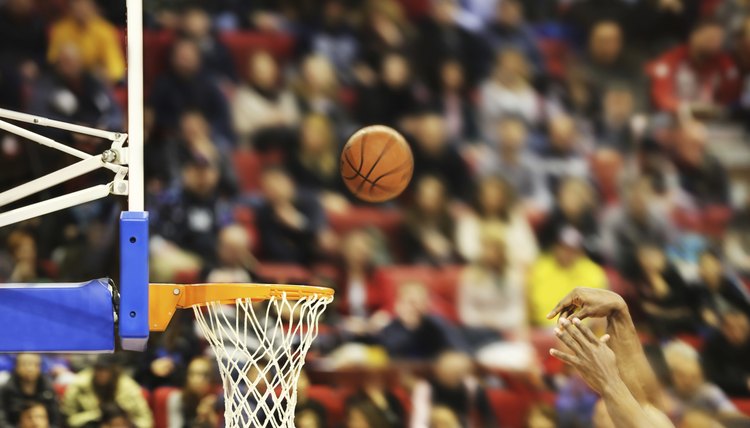Objectives of the Game of Basketball

Basketball was invented in 1891 by James Naismith. A graduate student and gym teacher, Naismith devised 13 rules for a game played between two teams using a soccer-sized ball. Lacking boxes just the right size to hold the tossed ball, Naismith nailed peach baskets to opposite ends of the gym. Today, basketball is played by children in neighborhood parks, by students in high school gyms and by college and professional teams in arenas that hold tens of thousands of spectators. The object of the game is to win points by shooting the ball into the opposing team's "basket." The team with the most points wins.
The Court and Ball
Naismith nailed his original peach baskets to the lower railing of the gym's lower balcony railing, which happened to be 10 feet high. That still is the regulation height of basketball nets. The net opening is 18 inches diameter -- double the size of regulation-size 9-inch diameter basketball. The nets are attached to backboards at each end of a rectangular court. The court is divided into two halves that mirror each other in the layout of three-point, free-throw, free-throw lane and out-of-bounds lines.
The Players
Basketball teams can have up to 15 players, but only five players from each team can be in play at one time. The centers are usually the team's tallest players. They score from close range, block opponent's shots and attempt to get the ball after an opponent attempts to score. The next tallest players are the forwards. They try to score from outside areas and corners. Guards are usually shorter, quicker players. They take the ball down court, pass the ball to the centers and forwards, guard the opposing team's guards and try to steal the ball from opponents. Teams have a head coach and an assistant at the lower levels, a head coach and multiple assistants at the college and pro levels, and competitive games have at least two referees.
Let the Game Begin
Basketball games are played in halves in high school and college, but the pro game consists of four quarters. The length of each half depends on the level of play, but normally each half is 20 minutes at the high school and college levels. Pro teams play four 12-minute quarters. Teams defend their own basket and score by shooting the ball into their opponent's basket. The game starts with the "tip off." A referee stands in the court's center, between players from each team. The referee tosses the ball in the air and each team's center attempts to hit it toward their teammates. The team of the player who gets the ball is on the offensive. The offensive team tries to drive the ball to their opponent's basket by dribbling, or bouncing it, or by passing it to a teammate. At the same time, the team playing defense tries to steal the ball or stop the opposition from scoring.
He Shoots, He Scores
A player who scores a basket from outside the arc-shaped line around each basket earns three points. Baskets scored from inside the arc are worth two points. A player who "travels," or moves without dribbling the ball, commits a turnover and loses the ball to the opposing team. Illegal contact with an opponent is called a foul. If illegal contact occurs while a player is shooting, that player gets to shoot from the free-throw line while the other players stand along the free-throw lane lines. A player who earns five fouls is out of the game and another player is substituted. At the end of the game, the team with the most points wins. If the game ends in a tie, the game goes into overtime.
References
Resources
Writer Bio
Laura Leddy Turner began her writing career in 1976. She has worked in the newspaper industry as an illustrator, columnist, staff writer and copy editor, including with Gannett and the Asbury Park Press. Turner holds a B.A. in literature and English from Ramapo College of New Jersey, with postgraduate coursework in business law.
